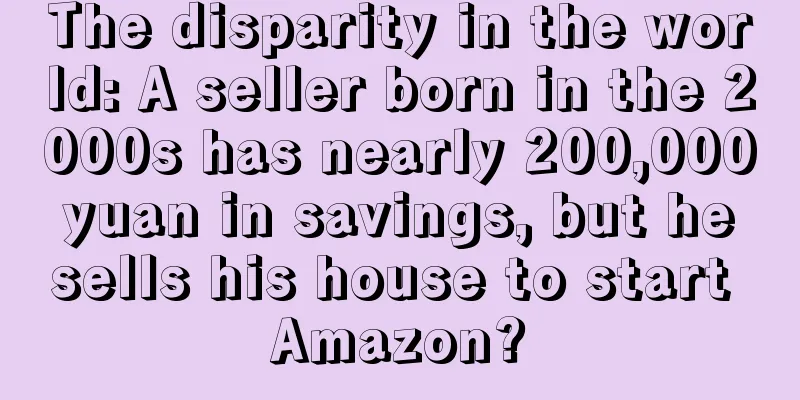Amazon traffic source analysis--Multi-channel to improve your product exposure search traffic, category traffic, ranking traffic, related traffic, etc.

|
1. Search traffic entrance The search traffic entrance is when consumers enter the keywords they want to buy in the front-end search box of Amazon according to their own purchasing needs. The Amazon system will match and display all the products on the platform according to the keywords entered by the buyer. Simply put, it is keyword search traffic, which is the most fundamental source of all Amazon traffic. The entire A9 principle is formed around natural search, which is also the most direct way for buyers to find products. The matching conditions include whether the keywords are consistent and some relevant elements of the product. Then Amazon's A9 algorithm will arrange them in order according to these relevances, as well as the sales of the product itself, the comprehensive performance score of the listing, the conversion rate and other factors, and display them to the buyer. The degree of keyword matching depends on whether the keyword entered by the buyer is in the listing. If your listing, title, five-point description, and product description contain a large number of search keywords, and the matching degree is very high, then this product will have a greater chance of being displayed, thereby obtaining more search traffic. In order to capture the traffic brought by keywords, sellers must find and use keywords accurately, which is the core and foundation of Listing optimization. In order to obtain as much keyword traffic as possible, you must find the right keywords. The so-called "right keywords" are the words that consumers may use to search for the product you sell. Regarding Listing keywords, it is not enough to have one or two core keywords, but it is necessary to dig out multiple long-tail keywords, because long-tail keywords are much easier to promote than some core keywords. Here, you can use accurate matching of advertisements or some real-person reviews to measure long-tail keywords with high relevance and large traffic. The underlying thinking of seizing the keyword traffic entrance is to learn to think from the perspective of others. You must understand both the product and the consumers. If you do not think from the perspective of the consumers, the keywords you choose may be biased. However, using the right keywords in the listing is only the first step. You should also pay attention to placing the core keywords in the most important position. The title is the module with the highest weight in the entire listing, so the selected core keywords should be used in the title as appropriately as possible, while the relatively less important keywords can be distributed in the ST keyword list, five-element features, product description and other modules. In addition to the keyword traffic entrance, we have to note that in the upper right corner of the search results page, Amazon provides consumers with filters for multiple conditions, including the system default comprehensive ranking, price from low to high, price from high to low, user ratings, shelf time, etc. These will become factors for consumers to choose and change keyword rankings when purchasing. In the latest Amazon search results page, more special columns have been added, including Editorial Recommendations recommended by the media, and Highly rated, well-priced products available to ship immediately, which are divided by price range. This is also a traffic entrance based on keyword search natural traffic. If sellers can respond to it in a targeted manner, they will definitely get more natural traffic. In addition, factors that affect search traffic include the logistics method of the goods. Simply put, the search traffic of FBA is much higher than that of self-delivery, so if you are making high-quality products, it is recommended to use FBA. 2. Ranking traffic entrance Amazon's rankings include sales rankings, which are Best Sellers; new product rankings, which are New Releases; and rising sales rankings, collection rankings, and gift rankings. The traffic of these rankings is relatively not as large as search traffic, but it is actually a part of the traffic that cannot be ignored. The collection ranking here can be operated by a third-party service provider by adding products to the wish list. The collection ranking page only displays the top three in each category. The better your listing sells, the higher its ranking will be. When it enters the Top 100 or even becomes a Best Seller, you will get more natural traffic. Therefore, the BSR ranking list is also a traffic portal that sellers should pay attention to. Becoming a Best Seller can get the Best Seller badge, and a listing that sells well can also get the Amazon's Choice badge. When your listing enters the top 100 in the category, it can enter the Top 100 ranking list. Furthermore, the list is divided into five categories: hot selling list, new product list, soaring list, collection list, and gift list. Although the weight of each list and the traffic it may bring are different, for sellers, once they enter these lists, they can get more traffic. At the same time, the BSR ranking list interacts with the ranking of the keyword natural search page. When a listing becomes a Best Seller, it will generally appear on the homepage of natural search. The weights are mutually enhanced, and the traffic is added up. Please note that Amazon has a 3-month traffic support period for new products. When promoting new products, you must seize this traffic support period and, through some evaluations and promotional activities, allow the new products to enter the top of the new product list. You can also stagger the time of releasing new products appropriately to ensure that new products are pushed to the New Releases rankings every once in a while. This will be of great help to the weight and ranking of the entire store. 3. Category traffic entrance In the search results, Amazon will also launch a category navigation on the left column, and consumers will click on the category navigation on the left to filter out results that are closer to their actual expectations in order to obtain more accurate results. This method is actually a popular way to find products. Users narrow down the range of products by selecting categories on the homepage and adding some additional conditions. For example, mobile phone accessories selected by category, mobile phone cases are narrowed down, and then the price range is used, and finally the products that you want to buy are found by turning pages. Therefore, category node traffic should also be a traffic entrance that sellers should pay attention to. Of course, the traffic of different categories is also different. Relatively speaking, the traffic of popular mainstream categories is relatively large. What we need to pay attention to is what category and which segmented node the product is placed under. The precise node determines the user's accuracy (accuracy determines the conversion rate) and how many competitors you have to face. At the same time, study the conditions of the filter box on the left, and then reflect them to the corresponding field attributes of your own product. Accurately grasping them will also help the exposure and conversion of the product. When launching new products, try to choose categories with less competition, large traffic, and that match the product. Because even if it is the same product, the effect will be different if it is promoted in different categories. Some categories have relatively less competition, so it is easier to get the Best Seller; while it is difficult to get the Best Seller in some large categories. Therefore, in the early stage of new product promotion, it is best to choose to rush to the Best Seller in a small category. After getting this label, it will be very helpful for the overall conversion rate of the listing. However, the category navigation on the left side of Amazon is often sorted according to the best match principle. If you blindly pursue small categories, it is very likely that the category will sink to the bottom of the category navigation, and consumers will click on the category nodes above. In this way, you may miss the traffic that the category navigation may bring to you. Therefore, regarding category node traffic, sellers should choose accurate categories as much as possible when publishing products, and should not excessively pursue small categories. At the same time, you can also contact customer service or use a third-party service provider to add category nodes. A product can have up to three category nodes, so you must choose the appropriate category to join. 4. Advertising traffic entrance There are three types of Amazon ads. The most common CPC ads are also called SP ads (Sponsored Product), as well as HS ads (Headline Sponsored) and PD ads (Product Display) in the AMS advertising system. The ad ranking of a product also determines a portion of the traffic, and the proportion is not small. The position of ad traffic is also equivalent to the position of natural ranking, but CPC is a way to make your product compete directly with other products in a paid way. Ad ranking affects a portion of user traffic, and the form of ad traffic is mainly keyword ad ranking. According to the setting form, SP ads are divided into automatic and manual types. According to the product display position, some SP ad listings will appear on the search results page, generally located at the top, middle and bottom of the page, and some SP ads will be displayed in the middle and bottom of the product details page, with two columns per page. Compared to natural traffic, which is influenced by factors such as the relevance, conversion rate, and number of orders of the listing, the listing with in-site advertising can influence the position of the listing through bidding in addition to the above factors. When you place an in-site advertisement for a listing, this listing gains another (or more) traffic entrance in addition to natural traffic, and more traffic entrances often mean more traffic, which can often bring more orders. From the perspective of orders, placing in-site ads for your own listings can form a virtuous cycle in operations to a certain extent. Of course, in order to make this virtuous cycle in logical reasoning a real virtuous cycle in operations, you need to focus on a series of advertising data indicators, including exposure rate, click-through rate, conversion rate, single click cost, etc. After the advertisement is placed, you need to regularly download advertising reports, conduct data analysis regularly, make corresponding adjustments in time according to the performance of the advertisement, and ensure that the input-output ratio of the advertisement is cost-effective through product selection and advertising optimization. 5. Activity traffic entrance There is often a "Deals" button below the Amazon search box. Click this button and Amazon will display the listings that are currently on flash sales promotion in different categories. There are many types of Deals on Amazon, such as the 6-hour LD flash sales, the two-week free BD flash sales, the king of flash sales DOTD, and various holiday promotion coupons, etc. These are all available only through recommendations or applications. Choosing some competitive products with good sales, good audiences, and participating will often have unexpected results. And these flash sales have different traffic page entrances. When promoting products, try to use all that can be used and integrate all resources to maximize traffic. Given the existence of many high-frequency consumers on Amazon (Prime members), the number of high-frequency consumers is huge, and the traffic of the flash sale entrance cannot be underestimated. For sellers, this entrance is an independent traffic entrance independent of other traffic entrances. If you want to grab the entrance to the flash sale traffic, you need your products to perform well and qualify for the flash sale, and you also need to pay the flash sale fee according to the platform's charging standards. Therefore, in grasping the entrance to the flash sale traffic, sellers need to evaluate their products and sales, and don't blindly participate in the flash sale. 6. Associate traffic entry A major feature of the Amazon platform is that it presents accurate products and more products to consumers through cross-correlations of products on the site, thereby firmly locking in users. By converting this feature to the sales level, associated traffic is also a traffic entrance that sellers should pay attention to. Simply put, Amazon's associated traffic includes columns such as Frequently Bought Together (FBT), Customers Who Viewed This Item Also Viewed, and Customers Who Bought This Item Also Bought. In comparison, the effect of FBT is relatively poor, but the effects of "Viewed This Item Also Viewed" and "Bought This Item Also Bought" are almost the same as in-site advertising. The key point is that this traffic is free. Product-related traffic is the largest source of traffic on Amazon, and it is also the most difficult one. A product's related network can be expanded infinitely. Constantly linking with similar competing products or complementary products will infinitely increase its exposure, and then use its own conversion rate advantage to form order conversion. Therefore, the correct choice of product association is also a very important part of the content. The associated traffic has a good effect and is a traffic entrance that many sellers want to obtain, but not every seller can get what they want. Combining previous operating experience, if you want your products to get more slots and displays at the associated traffic entrance, you need to have two elements: first, be associated with yourself. The products of your own store need to be cross-related and related. That is, only a store that focuses on one category in depth can more easily form a connection between the products in its own store; second, sell well. The higher the sales volume of a listing, the higher the ranking, and the easier it is to be captured by the Amazon system and matched to the pages of other similar products. Therefore, if you want to make good use of the traffic on your site, in the final analysis, you still have to be focused enough and perform well enough. (Compiled from: Cross-border e-commerce Winners Club, Kuso King) |
<<: Foreign media review: 26 most promising e-commerce products in 2019
Recommend
Survey on American Consumer Browsing and Purchasing Habits! 35% of people discover new brands on Amazon!
According to Emplicit, nearly all (86%) U.S. consu...
What is Find Your Influence? Find Your Influence Review
Founded in 2013, Find Your Influence is the leadin...
The seller quit his job and wanted to transform! Is Amazon live fitness recruiting investors?
▶ Video account attention cross-border navigationI...
On the 24th, Alice wants to tell you about complaints and the new advertising policy...
Yes, we have prepared the following three topics o...
What is a clearing service? Clearing service review
Liquidation is a free removal option, through whic...
Amazon's new team is established! Another driving force for customs inspection
Since the last time ACCU seized the service provid...
Get a free 2022 cross-border e-commerce calendar! Hot product recommendations, stocking reminders, and festivals from all over the world are all included. It's super practical!
Get a free 2022 cross-border e-commerce calendar! ...
Nine minefields of Amazon operations
When optimizing your product, you must consider th...
How to drive external traffic to your Amazon page?
According to relevant statistics, only 75% of sale...
What is Ocean Int Ltd? Ocean Int Ltd Review
Since its establishment, Ocean International has b...
What is TMclass? TMclass Review
The Common Trademark Classification database joint...
Creating a high-quality listing page (Amazon account manager PPT)
What I want to share with you today is how to crea...
After the Ukrainian-Russian war officially broke out, how big an impact will it have on cross-border sellers!
The recent war between Russia and Ukraine was a bi...
Facebook Ads Beginner's Guide: Learn about Facebook Ads Reach Objectives in One Article
Want your Facebook ads to be shown to your target ...
What is Droom? Droom Review
Droom is India's third largest e-commerce comp...









